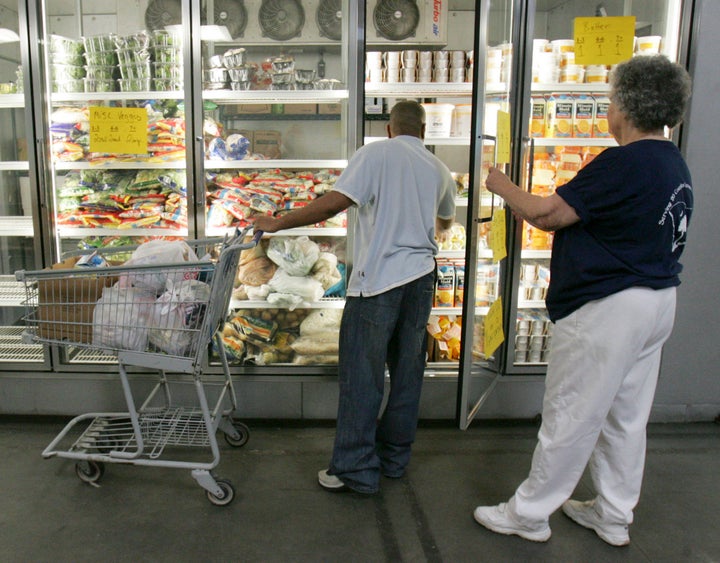
JACKSONVILLE, Fla. -- Rhetoric about jobs is everywhere during this campaign season. To emphasize how much they want to create jobs and how valuable small businesses are, candidates frequently stop by local businesses for a photo op and to tell the staff to keep up their hard work.
But with national unemployment at 8.5 percent, jobs are in short supply. The harsh reality that doesn't make for a nice photo op is that many Americans fall through the cracks, and no matter how hard they search, they're unable to find a full-time job that pays enough to cover food, health care, housing and other necessities of life -- and they need extra assistance. Sometimes it's from the community, and sometimes it's from the government.
These people and their struggles rarely pop up on the campaign trail, except as talking points about the need to create more jobs. Rarely, however, is there a deeper discussion of how to provide assistance until those jobs come. Mitt Romney did sit down and talk with a group of unemployed Americans in June, but the event ended up reinforcing the image that he was out of touch when he, a millionaire, joked with them that he was also unemployed.
Just 20 minutes away from where all the GOP candidates gathered Thursday night for a presidential debate is Second Harvest North Florida, a food bank serving 17 counties and reaching 2 million people -- the largest geographic reach of any food bank in the entire state.
A nondescript building located on a manufacturing road with large tractor trailers loading and unloading all day long, going to the food bank certainly lacks the wow-factor of doing events highlighting the space industry or the folksy charm of going to a local diner -- both key stops for candidates in Florida.
No presidential candidate visited the food bank while in the city this year. Second Harvest North Florida's director of communication Tom Strother has been there since 2008. The last federal official or candidate he can remember stopping by was Kendrick Meek (D), when he unsuccessfully ran for the U.S. Senate in 2010.
When issues of poverty and food stamps have come up during this election season, they have usually been used as political attacks rather than in a discussion about how to help Americans who are struggling to get back on their feet.
Both Strother and Jim Chynoweth, the food bank's director of agency relations and distribution, think there's a more productive way of looking at the issue.
"Food stamps are, as our executive director likes to put it, an investment in recovery," said Strother. "Because a lot of times the people who are eligible for these food stamps, they're folks who have just come on hard times. They didn't do anything wrong. They followed all the rules, they lived their lives the right way and the economy smacked them in the face. ... Maybe this is a short-term solution for them to help them get through difficult times."
Second Harvest North Florida has an innovative program in Flagler County pairing the nonprofit community, local government and the local Chamber of Commerce to get more people who are eligible for food stamps -- known officially as the Supplemental Nutrition Assistance Program (SNAP) -- actually enrolled in the program. Why? Besides giving people the assistance they need, it helps the local economy. In fact, the U.S. Department of Agriculture estimates that every dollar of SNAP benefits spent results in $1.80 in economic impact.
When the groups started the Flagler County program in August, they estimated that only 64 percent of the people who were eligible for SNAP were actually enrolled in the program. In other words, there were over 3,000 more households in the country that were eligible, worth $11.5 million a year in unclaimed benefits. That equals $20.7 million a year in economic impact.
"So the Chamber of Commerce looked at this and said, I want those dollars being spent at my convenience stores and my Winn-Dixies and my Publix and my Wal-Marts, because that's going to mean they have to retain or hire more bag boys and cashiers. It means they're going to have more dollars available for maintenance and repairs and lights and paving and all the ancillary services that come along with dollars flowing into the community," said Chynoweth.
Between August and December, the coalition was able to enroll 135 households in SNAP.
Strother and Chynoweth recognize that, ideally, everyone would have jobs and no one would need to come to a food pantry or be on SNAP. But until that day arrives, people need extra assistance to get back on their feet.
"At the end of the day, when people find themselves in that situation, we want to be sure they're getting the help they need," Chynoweth said. "Regardless of whether they did or didn't deserve to be in that situation or whose fault or party is or isn't responsible for creating jobs, at the end of the day, there's a single working mom with two kids who needs help, and we want to make sure she gets that."
The need in the community, in fact, continues to grow. Second Harvest North Florida, like other food banks around the country, has partnerships with local retailers and "rescues" products that will either be discarded or taken off the shelves. In 2008, it moved 7.6 million pounds of food through their warehouse. Last year, it had 20 million pounds. The increase was "a direct reflection in demand," according to Strother. Member agencies like the Salvation Army and soup kitchens take food from Second Harvest North Florida and then distribute it to individuals in need.
Second Harvest also has a small food pantry open for three hours each day. People are allowed to come only once, however, and are then guided to member agencies in their own communities so that they can get more direct assistance. In 2008, when Strother started, there were five to 10 people coming a week. Now there are 25 to 30 people a day.
"Most of the families we work with -- they're not living on the food we provide," said Chynoweth. "They can take SNAP dollars and buy this many groceries. Then go to the food pantry and get this many groceries. They're buying, with the dollars they earn working as a cashier at Wal-Mart, they can buy some groceries. Their family is helping them out. Together, that meets their need. But no one is living on any one of these programs by themselves."
In the recession, corporate donations to the food bank have plummeted, but individuals have stepped up to help out. Still, it's not enough. Strother said they should be moving 40 million pounds of food to meet the need in their 17-county area. That, however, would mean raising $7 million a year and doubling the amount of food they currently provide.
Strother said he thinks it could be educational for political candidates to come to the food bank to get a real picture of how people are struggling in the recession.
"Because if you come to the food bank -- depending on the time of the day you come -- you can talk with our member agencies. You can talk with people who have lined up who need assistance individually. You can talk with staff here who see the types of products coming in and out and have a better understanding of how the nonprofit community is making an impact on this issue. I think it could be educational for politicians [and] candidates to come by," he said.
But, added Strother and Chynoweth, it would probably be best to leave the media behind -- otherwise, it would probably just become another hollow photo op.

